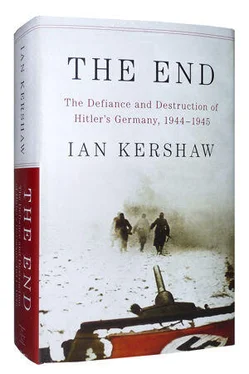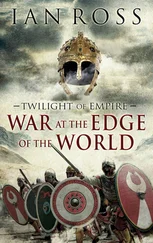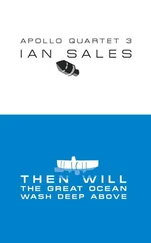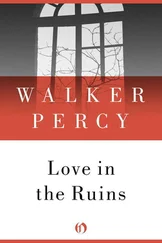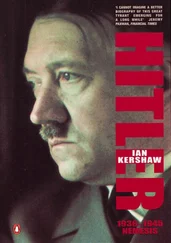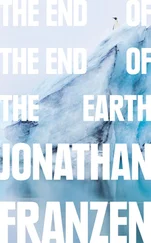134. Ruth Andreas-Friedrich, Schauplatz Berlin: Ein deutsches Tagebuch , Munich, 1962, p. 166 (21.4.45).
135. DZW , 6, p. 707.
136. BA/MA, NL Heinrici, NL265/108, fos. 11–15, 39–40, 54 (15.5.45).
137. DZW , 6, p. 734.
138. BA/MA, NL Heinrici, NL265/108, fos. 52–7 (15.5.45).
139. BA/MA, NL Heinrici, NL265/108, fos. 22–5, 39–41 (15.5.45).
140. BA/MA, NL Heinrici, NL265/108, fo. 29 (15.5.45).
141. DZW , 6, pp. 705–26, DRZW , 10/1 (Lakowski), pp. 656–73, Erickson, pp. 577–618, and Beevor, ch. 21, provide detailed descriptions of the battle of Berlin.
142. Jodl admitted this to Colonel-General Heinrici on 13 May 1945.—BA/MA, NL Heinrici, N265/108, fos. 57–8 (15.5.45).
143. Steiner had well-warranted reasons for not undertaking the attack and was despairing at being given an order which was, as all with any insight into the position knew, impossible to carry out. See BA/MA, NL Heinrici, N265/108, fos. 19–22 (15.4.45).
144. The uncertainty, also regarding Göring’s position, produced by Hitler’s breakdown is plainly summarized in the report sent three days later to Hitler by General Karl Koller, Chief of Staff of the Luftwaffe.—IWM, EDS, F.3, AL 1985 (2), ‘An den Führer. Bericht über die wesentlichen Punkte der Vorgänge am 22.4. und meiner Meldung an den Herrn Reichsmarschall am 23.4.’ (25.4.45). A brief description of Hitler’s remarks, recorded by an eyewitness, Oberleutnant Hans Volck, adjutant to the Luftwaffe Operations Staff, is in IWM, EDS, F.3, AL 1985 (1), ‘Meldung über Führerlage am 22.4.1945. Lagebeginn: etwa 15.30 Uhr’ (25.4.45). There are minor discrepancies between Koller’s report and his subsequent publication, Karl Koller, Der letzte Monat: Die Tagebuchaufzeichnungen des ehemaligen Chefs des Generalstabes der deutschen Luftwaffe vom 14. April bis zum 27. Mai 1945 , Mannheim, 1949, pp. 28–32.
145. Speer, pp. 479, 484.
146. BA/MA, NL Heinrici, N265/108, fos. 38–9 (15.4.45).
147. BA/MA, NL Heinrici, N265/108, fos. 41–4 (15.4.45).
148. IfZ, ZS 145, Bd. III, Schwerin von Krosigk, fo. 61 (7.12.62).
149. IfZ, ZS 988, Friedrich Wilhelm Kritzinger, interrogation by Dr Robert Kempner, fos. 4, 7, 10 (5.3.47).
150. Krosigk wrote to Speer on 29 March, in the framework of discussions over ‘scorched earth’, suggesting that intensified Allied bombing had been caused by the desire not to let German industry fall into Soviet hands, and that the more Germany’s industrial potential was preserved the greater the bargaining position with the west would be. On 6 April, urgently seeking a meeting with Goebbels, he pressed for action to create the conditions for Britain to break away from the enemy coalition, which he thought was eminently possible. He wrote again to Goebbels on 14 April, describing Roosevelt’s death as a ‘present from God’ that had to be actively exploited, recommending an approach from the Pope to America, which, he claimed, had an interest in German industry as a barrier to a strengthened Soviet state.—All in IWM, EDS, F.3, M.I. 14/369.
151. IfZ, ZS 145, Bd. III, Schwerin von Krosigk, fos. 58–61 (7.12.62).
152. StAA, Gauleitung Schwaben, 1/29, fo. 328836, file note, presumably for Gauleiter Wahl, 20.4.45.
153. StAA, Gauleitung Schwaben, 1/37, unfoliated, note of telephone call from the Kreisleiter of Lindau, n.d., c. 24–6.4.45. Lindau, where reports suggested that up to 60 per cent of the population could be seen as pro-Nazi, remained a trouble spot for the French occupying authorities (in a region that gave them some security headaches) for some weeks after the end of the war. There were some disturbances, cases of apparent arson, and a French officer was shot dead by a fourteen-year-old former member of the Hitler Youth. Much of the town’s population was for a short time forcibly evacuated and only allowed to return, two days later, after grovelling pleas for clemency. French troops arriving in the meantime had ransacked much of the empty town. The whole affair was an embarrassment to the French, and shocked American and Swiss observers.—Perry Biddiscome, Werwolf! The History of the National Socialist Guerrilla Movement 1944–1946 , Toronto and Buffalo, NY, 1998, pp. 260–63.
154. Justiz und NS-Verbrechen , vol. 2, pp. 236–52; IfZ, ED 195, Slg. Schottenheim, vol. 1, pp. 87–91 (written to show the author, Dr Otto Schottenheim, a doctor and the Nazi mayor of Regensburg since 1933, in the best light); Henke, p. 854; Dieter Albrecht, ‘Regensburg in der NS-Zeit’, in Dieter Albrecht (ed.), Zwei Jahrtausende Regensburg , Regensburg, 1979, p. 200, also for Ruckdeschel quotation: ‘Regensburg wird verteidigt werden bis zum letzten Stein.’ For Schottenheim, who died in 1980 an honoured citizen despite his Nazi past, see Helmut Halter, Stadt unterm Hakenkreuz: Kommunalpolitik in Regensburg während der NS-Zeit , Regensburg, 1994, pp. 77–87, and Albrecht, pp. 195–6. Ruckdeschel was sentenced in 1948 for his part in the Regensburg killings to eight years in a penitentiary (a sentence extended to thirteen years in a further trial the following year for ordering the execution of a civilian in Landshut on 29 April 1945).— Justiz und NS-Verbrechen , vol. 2, pp. 234–346; Justiz und NS-Verbrechen , vol. 3, ed. Adelheid L. Rüter-Ehlermann and C. F. Rüter, Amsterdam, 1969, pp. 763–94. Ruckdeschel died peacefully in Wolfsburg in 1986.—Miller and Schulz, vol. 1.
155. Troll, pp. 660–71; Henke, pp. 854–61; Heike Bretschneider, Der Widerstand gegen den Nationalsozialismus in München 1933–1945 , Munich, 1968, pp. 218–39; Klaus Tenfelde, ‘Proletarische Provinz: Radikalisierung und Widerstand in Penzberg/Oberbayern 1900 bis 1945’, in Broszat, Fröhlich and Grossmann, vol. 4, pp. 374–81; Georg Lorenz, Die Penzberger Mordnacht vom 28. April 1945 vor dem Richter , Garmisch-Partenkirchen, 1948, pp. 5–11; Justiz und NS-Verbrechen , vol. 3, pp. 100–101; Justiz und NS-Verbrechen , vol. 13, ed. Irene Sagel-Grande, H. H. Fuchs, and C. F. Rüter, Amsterdam, 1975, pp. 532–40. A sixteenth victim was shot ‘while in flight’.—Tenfelde, pp. 378, 380. The post-war trials relating to the murders in Altötting and Munich are in StAM, Staatsanwaltschaften 34876/25 (Altötting) and StAM, Staatsanwaltschaften 6571, 18848/2–3, ‘Fall Salisco’ (Munich). For an assessment of varied forms of resistance towards the end of the war, see Edgar Wolfrum, ‘Widerstand in den letzten Kriegsmonaten’, in Peter Steinbach and Johannes Tuchel (eds.), Widerstand gegen den Nationalsozialismus , Bonn, 1994, pp. 537–52. The Penzberg mine was not destroyed at the end of the war, and ceased production only in 1966.—Tenfelde, p. 382.
156. Das letzte halbe Jahr , p. 334 (10.4.45).
157. BA/MA, N648/1, NL Dethleffsen, Erinnerungen, fo. 39.
158. Ingrid Hammer and Susanne zur Nieden (eds.), Sehr selten habe ich geweint: Briefe und Tagebücher aus dem Zweiten Weltkrieg von Menschen aus Berlin , Zurich, 1992, p. 358 (23.4.45).
159. Anonyma: Eine Frau in Berlin. Tagebuch-Aufzeichnungen vom 20. April bis 22. Juni 1945 , pb. edn., Munich, 2008, p. 30 (23.4.45).
160. Anonyma , pp. 9–15, 20, 24–5, 34, 39 (20–25.4.45).
161. VB , Munich edn., 20, 24, 25.4.45.
162. Anonyma , pp. 19–20 (21.4.45), 30 (23.4.45), 43 (26.4.45); Kronika, pp. 138, 152–3 (23.4.45).
163. Andreas-Friedrich, pp. 166–7 (21.4.45).
164. ‘Full of anxiety we went back into the cellar and awaited what might come,’ noted one diarist.—Hammer and zur Nieden, p. 364 (26.4.45)
165. Longerich, pp. 750–51; Peter Padfield, Himmler: Reichsführer-SS , London, 1990, pp. 593–8.
Читать дальше
